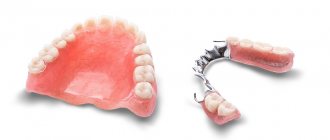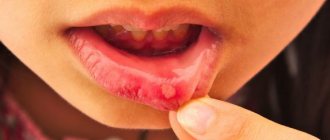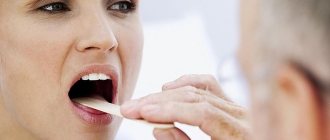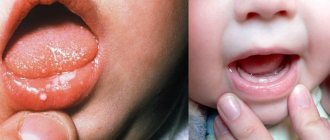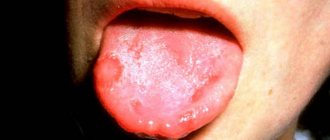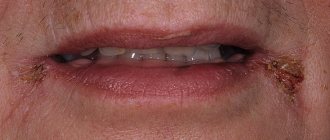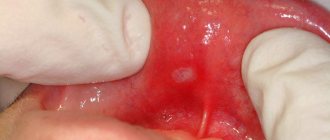Causes of aphthous stomatitis
The exact cause of this disease remains unclear. It is assumed that HRAS is of an allergic nature; allergens can include: food, medicine, toothpastes, dust, worms.6,7 It is also assumed that the cause of the disease is an autoimmune reaction.8 A hereditary predisposition to this disease can be traced.
Predisposing factors:
- diseases of the digestive system (gastritis, gastric ulcer, cholecystitis, Crohn's disease)
- dysbacteriosis
- stress
- deficiency of iron, vitamins B1, B2, B6, B12, C
- chronic tonsillitis, otitis and rhinitis
Treatment at home and folk remedies
As an addition to the main therapy, it is possible to use folk remedies. Ginseng, propolis and echinacea are considered good immunomodulators. Infusions of chamomile, propolis or oak bark help cope with inflammation; aloe and sea buckthorn oil promote healing of aphthae. In any case, it is unlikely that you will be able to get rid of the disease using folk remedies alone, so do not delay in visiting a doctor. Timely therapy helps cure aphthous stomatitis and eliminate its symptoms within two weeks. Advanced stages are much more difficult to respond to and can cause irreversible deformation of soft tissues.
Attention!
Conservative therapy implies the possibility of treatment at home, but a visit to a doctor is still necessary, since only a specialist can draw up an optimal rehabilitation plan (including prescribing an ointment, solution, antibiotics, anti-inflammatory drugs, etc.) and track intermediate results.
HRAS classification:
| CAUSES | A COMMENT | ||
| causes: | Clinically, several forms of HRAS are distinguished: | a comment: | 1) fibrinous form: the size of aphthae is 2-3 mm, heal in 6-8 days 2) small canker sores (Mikulich’s aphthae): the size of aphthae is up to 1 cm, heal in 10-14 days 3) large Setton’s aphthae: the size of aphthae is from 1 to 3 cm, heal for a very long time, up to several months, leaving scars 4) herpetiform type: the smallest aphthae that merge |
| causes: | HRAS as a symptom of the disease: | a comment: | 1) Behcet's disease 2) Reiter's disease |
| causes: | According to severity, HRAS is divided into: | a comment: | 1) mild form: 1-2 aphthae, once every 2 years 2) moderate form: 3-6 aphthae, relapse 2 times a year 3) severe form: more than 6 aphthae, relapse several times a year |
Treatment
To properly treat the disease, you need to see a doctor. He will diagnose and develop a therapeutic regimen. The goal of treatment is to destroy viruses and fungi to achieve remission or complete recovery. Therapeutic measures include local and general procedures. Drugs are selected depending on the severity of the disease. Local therapy includes treatment of the oral cavity with chlorhexidine and nitrofural. For pain, a glycerin suspension with novocaine or lidocaine is used. When the patient suffers from allergies, the mixture includes trasylol, hydrocortisone, and heparin.
If aphthous stomatitis is detected in children, allergists, gastroenterologists, and dentists are involved in treatment. Antiseptic drugs are prescribed: Lugol, iodinoloma, hexoral. To strengthen the immune system, vitamins C and B are prescribed. The chronic form is treated with immunological drugs. In case of exacerbation, adults are prescribed enzymatic agents. Citral solution will accelerate epithelization. Corticosteroid ointments and desensitizing agents are used. For mild cases of the disease, you can rinse your mouth with a solution that contains the steroid dexamethasone, which reduces inflammation. Besides:
- Healing is accelerated by benzocaine, fluocinonide, and hydrogen peroxide, which are used topically. The drug must be prescribed by a doctor.
- Medicines are taken internally for severe forms of the disease. Sucralfate may be recommended. It is used in the treatment of intestinal ulcers, as well as colchicine, which treats gout. If such therapy is unsuccessful, steroids are prescribed.
- Aphthae are cauterized with chemicals or special instruments. Cauterization is carried out using debacterol if the patient has problem gums. For chemical cauterization, silver nitrate is used.
If serious problems are detected in the body, treatment of the underlying disease is carried out. During treatment, a soft, gentle diet is practiced. You should rinse your mouth frequently with antiseptics.
HRAS as a symptom of the disease
Behçet's disease is a disease of unknown etiology, characterized by vascular damage, the appearance of aphthae in the oral cavity and genitals, damage to the eyes, joints, gastrointestinal tract, central nervous system and other organs. It has a chronic course and, if left untreated, can lead to disability.9
Symptoms:
HRAS
HRAS is the earliest symptom of the disease; aphthae can be of any size, recur at least 3 times a year, and are often located on the mucous membrane of the cheeks, lips, gums, tongue
Eye damage
Uveitis (inflammation of the membrane of the eye), blurred vision, “fog” before the eyes, redness of the eyes (rarely), lacrimation
Genital ulcers
Similar to mouth ulcers, but deeper and more painful
Skin redness
The skin exhibits erythema nodosum (red, painful subcutaneous nodules), rash
Other
- vessels in the form of thrombosis, aneurysms
- Nervous system damage: coma, meningitis, confusion
- joints may also be affected in the form of arthritis
Reiter's disease is a systemic infectious disease characterized by damage to the oral mucosa, genitourinary system, eyes and joints.10 The triggering factor for infection is often chlamydia and gonococci, and there is also a genetic predisposition. The disease has a severe course, and in case of complications it leads to disability (blindness, deforming arthritis) and even death.
It is important to remember that HRAS may indicate the presence of a serious systemic disease.
Symptoms of the disease
Signs of aphthous stomatitis depend on the form and stage of the disease.
The following stages of aphthous stomatitis are distinguished:
- Initial.
- External manifestations.
- The appearance of pathological foci.
- Healing.
The initial stage is characterized by general malaise and enlarged lymph nodes in the neck, back of the head and jaws. The patient's body temperature rises and his appetite worsens, he feels weak.
At the stage of external manifestations, local symptoms (changes in the oral mucosa) join the above-described signs. These include:
- Edema.
- Pain, aggravated by eating and hygiene procedures.
- Redness and congestion with blood (hyperemia).
- Palpable itching.
The patient may also experience sleep disorders.
During the stage of appearance of pathological foci, single or multiple aphthae occur. They can develop on any part of the oral mucosa, but are most often observed on the cheeks, lips, palate and tongue. Ulcers are usually quite painful.
During the healing stage, the aphthae is gradually covered with epithelial tissue. In most cases, no scars are left.
Forms of aphthous stomatitis:
Fibrinous aphthous stomatitis is the mildest form, resulting from impaired circulation in the superficial layer of the mucous membrane. Single painful ulcers covered with a white coating appear in the mouth. Healing of aphthae occurs within 1–2 weeks.
The granular form develops due to a lack of saliva. With this type of disease, the minor salivary glands are affected, causing them to produce less secretion. Due to the dryness of the mucous membrane, painful and long-lasting ulcers occur near the excretory ducts of the glands. In patients prone to frequent colds, granular stomatitis can develop into a chronic form. The treatment is quite long - it takes from 1 to 3 weeks.
Necrotizing aphthous stomatitis is characterized not only by the presence of ulcers, but by the slow destruction of the outer layer of the oral mucosa, resulting in tissue death. Unlike other forms of the disease, this one is not accompanied by pain and discomfort. This type of pathology is rare. Necrotizing aphthous stomatitis is usually observed in adults suffering from any severe systemic diseases.
The scarring form occurs when the minor salivary glands and connective tissue are damaged, caused by genetic failures. The ulcers are small at first, but get larger over time. They are very painful. Aphthae in this type of disease are located in the projection of the salivary glands, mucous membrane of the pharynx and anterior palatine arches.
Deforming is the most complex form. It causes a lot of inconvenience to the patient, as it is accompanied by general malaise and significant pain. The ulcers are quite deep and do not go away for a long time. They lead to deformation of the lips, anterior palatal arches and the soft part of the palate. Microstoma (narrowing of the mouth) may also develop when the corners of the mouth are affected.
Reference! A complication of aphthous stomatitis is the spread of infection through the tissues, as well as the progression of the acute form to the chronic form.
Prevention of HRAS
Prevention should be aimed at monitoring the state of health in general, treating chronic diseases, and it is necessary to undergo regular examinations regarding the existing disease. Hardening and strengthening the immune system have a good effect. You need to visit the dentist to monitor your oral health once every 3-4 months to ensure timely detection of relapses. You should avoid using toothpastes, hygiene products with dyes or identified allergens. Taking antibiotics should only be done under the supervision of a doctor. It is recommended to avoid strong psycho-emotional stress and regularly carry out wet cleaning of the premises.
It is worth paying attention to Tantum® Propolis .
Tantum® Propolis
Propolis has an immunostimulating effect, promotes healing, vitamin C, which is part of it, is responsible for regeneration, participating in the synthesis of collagen.
Propolis also has antiviral and antifungal effects. Therefore, vitamin therapy Tantum® Propolis is an effective means of preventing stomatitis12 Find out more
Diagnostics
Aphthous stomatitis is usually diagnosed after examining the patient, based on the clinical picture and history. However, if the doctor suspects the presence of concomitant diseases, then additional tests are prescribed aimed at identifying them (blood and urine tests, ultrasound, etc.).
Differential diagnosis may also be needed. It is important to differentiate aphthous stomatitis from herpetic stomatitis and from chronic injuries of the oral mucosa. For this purpose, virological studies are prescribed and the immunofluorescence method (ELISA) is used.
What predisposes to recurrent oral aphthae?
Perhaps the microflora of the oral cavity, herpes group viruses, and maybe Helicobacter pylori, a microorganism that causes stomach and duodenal ulcers, play some role.
Also influence:
- injuries to the oral mucosa
- stress
- deficiency of vitamins B12, B1
- vitamin D deficiency
- zinc deficiency
- poor oral hygiene
- nitrates in drinking water
- Sodium lauryl sulfate is a very popular surfactant in the industry, which is often added to toothpastes for better cleaning and foaming effect.
- food allergies (eg, cow's milk protein) or food hypersensitivity (cinnamon, coffee, chocolate, cheese, figs, pineapple, citrus fruits, some spices)
- non-steroidal anti-inflammatory drugs
It is very important to understand: recurrent aphthae is an independent disease (most often this happens) or a manifestation of some systemic disease.
The latter option is rare, but the doctor should always keep in mind the possibility of this situation.
What can help in finding the cause of aphthae?
A conversation sometimes helps to find out whether relatives have important diseases with a family predisposition - celiac disease, Crohn's disease, lupus erythematosus.
During the examination, the doctor can evaluate the general manifestations of the disease (not typical with ordinary recurrent aphthous stomatitis) and check for the presence of ulcers outside the oral cavity.
The simplest laboratory examination is carried out - this is most often enough.
A general blood test may show anemia due to deficiency of iron, folic acid, and vitamin B12.
The level of neutrophils is also assessed - their decrease may be a sign of the rare systemic disease cyclic neutropenia
A high ESR may be a sign of Crohn's disease and ulcerative colitis.
Serum iron levels may be reduced in up to 20% of recurrent canker sores.


